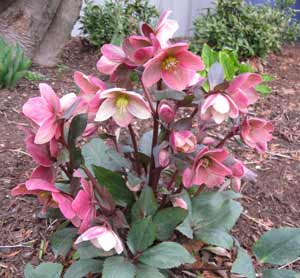 The "Christmas rose" type of hellebore is becoming a popular holiday potted plant.
The "Christmas rose" type of hellebore is becoming a popular holiday potted plant.
iStock/Thinkstock
Not many plants can thrive in a shady spot, around the roots of mature trees, and faced with the chance of becoming deer food. But hellebores have just the survival skills needed to face such a challenge. These tough perennial flowers have leaves that are toxic when eaten causing animals to generally avoid them. In addition their roots are strong enough to compete with that of trees.
The most common type, nicknamed the Lenten rose, is an early-blooming perennial with hanging, bell-shaped flowers of pink, white or lavender. It’s one of the first perennials to flower, blooming in February or March in most of the country. In all but the coldest regions, plants hold their dark-green leaves through winter, making it an evergreen perennial.
 Newer varieties of hellebores have showier, outward-facing flowers. This variety is "Pink Frost".
Newer varieties of hellebores have showier, outward-facing flowers. This variety is "Pink Frost".
George Weigel
Improving the Hellebore
Advances in breeding are making the hellebore more mainstream, with many new color blends and hybrids with different features. One of these features can be seen in most newer hellebore hybrids, which have flowers that are outward-facing, making them showier than the traditional downward-facing ones.
Another member of the family, the Christmas rose (Helleborus niger), blooms even earlier than other hellebores. It flowers as early as mid-winter and is easy to force into bloom in a greenhouse. This has made it an increasingly available December potted-plant choice alongside poinsettias.
How to Grow Hellebores
Hellebores grow well in part to full shade, including wooded areas and areas around trees that are typically are drier (or, receive less moisture). Most grow 2 to 3 feet tall. Plant hellebores in spring or early fall. Work an organic-rich fertilizer into the loosened soil at planting, water well, then cover the ground with 2 inches of weed-smothering mulch. Fertilize each spring and early fall to encourage best bloom.
Clumps can be dug and divided after bloom or in early fall. Let the leaves stand as long as they’re green, and snip them and spent flowers only after they turned brown.